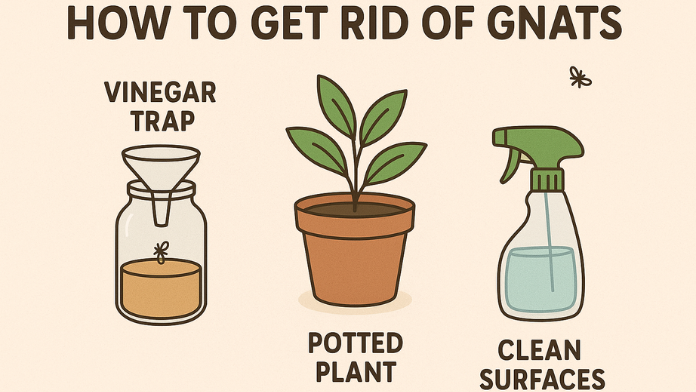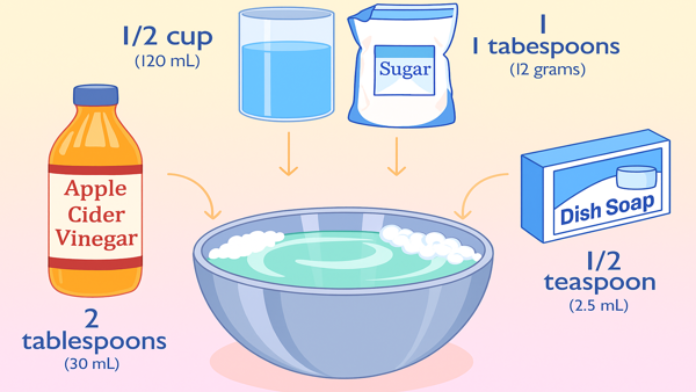
Gnats are tiny but tenacious pests that can quickly turn your peaceful home into a buzzing nightmare. Whether they’re hovering around your fruit bowl, invading your plants, or multiplying in the kitchen drain, gnats seem to appear out of nowhere—and multiply overnight. The good news? You don’t need harsh chemicals or expensive exterminators to reclaim your space. In this complete guide, you’ll learn how to get rid of gnats naturally using simple, safe, and effective home remedies. From identifying what’s attracting them to creating easy DIY traps, we’ll cover every step you need to eliminate gnats fast—and keep them from coming back.
Understanding the Gnat Problem
Before you eliminate gnats, it’s essential to understand what they are and why they appear. Not all gnats are the same, and different types require slightly different solutions.
What Are Gnats?
“Gnats” is a general term for small flying insects, typically from families like fungus gnats, fruit flies, and drain flies. Although tiny, their presence can signal larger hygiene or moisture issues around your home.
- Fungus gnats thrive in moist soil and are often found around indoor plants.
- Fruit flies love overripe fruits, vegetables, and sugary spills.
- Drain flies breed in damp, organic buildup in sinks, drains, and garbage disposals.
Knowing which type of gnat you’re dealing with helps you target their breeding source directly.
What Attracts Gnats to Your Home and How to Get Rid of Gnats?
Gnats don’t invade randomly—they follow scent trails of organic decay, moisture, and food. Common attractants include:
- Overripe or rotting fruit on countertops
- Damp potting soil or overwatered plants
- Dirty kitchen drains or wet garbage bins
- Food residue on dishes and trash lids
- Standing water or leaking pipes
The Root Cause: Moisture and Decay
Gnats thrive where organic material breaks down—moisture speeds up this process. That’s why kitchens, bathrooms, and plant corners become their favorite breeding grounds.
How to Get Rid of Gnats Naturally at Home

Now that you know what draws gnats, let’s look at natural and safe ways to eliminate them from your home environment.
1. Apple Cider Vinegar Trap
One of the most effective and eco-friendly gnat traps is made from vinegar.
How to make it:
- Fill a small bowl with apple cider vinegar.
- Add a few drops of dish soap to break surface tension.
- Cover with plastic wrap and poke small holes on top.
Gnats are drawn to the vinegar’s scent, fall in, and drown. This trap works wonders in kitchens and near fruit bowls.
2. Red Wine or Beer Trap
Gnats can’t resist the fermentation smell. Pour a little red wine or beer into a jar with a drop of dish soap. Leave it uncovered overnight near affected areas. The gnats will be lured by the aroma and get trapped.
3. DIY Lemon and Clove Repellent
For a natural repellent, cut a lemon in half and press whole cloves into the surface. Place it on the kitchen counter overnight. The citrus and spice scent deters gnats and leaves your space smelling fresh.
4. Essential Oils for Gnat Control
Certain essential oils repel gnats effectively without any toxic residue.
Top oils to use:
- Peppermint oil
- Eucalyptus oil
- Lemongrass oil
- Tea tree oil
How to use:
Mix 10 drops of oil with ½ cup of water and a teaspoon of witch hazel or alcohol. Spray it around windows, drains, and plant soil.
5. Banana Trap for Fruit Flies
Mash half a banana in a jar, cover it with plastic wrap, and poke small holes. Fruit flies rush in but can’t escape. Dispose of the jar after 24 hours.
6. Vinegar and Baking Soda Drain Flush
For how to get rid of gnats in house drains, this natural cleaner does double duty—kills larvae and cleans the pipes.
Steps:
- Pour ½ cup baking soda down the drain.
- Follow with 1 cup vinegar.
- After fizzing stops, pour boiling water to flush it clean.
This kills gnat eggs and removes their organic breeding film.
How to Get Rid of Gnats in Plants Naturally
If gnats are buzzing around your plants, fungus gnats are the culprit. Overwatering and organic soil matter give them ideal breeding conditions.
1. Let the Soil Dry
Fungus gnat larvae live in moist soil. Allow the top 2 inches to dry before the next watering. It starves the larvae of moisture and oxygen.
2. Add a Sand Layer
Covering soil with a thin layer of sand or decorative gravel prevents adult gnats from laying eggs in the dirt.
3. Neem Oil Spray
Neem oil is a natural pesticide that disrupts gnat life cycles. Mix 1 teaspoon of neem oil per liter of water and spray it onto the soil and leaves weekly.
4. Cinnamon Powder Treatment
Cinnamon acts as a natural fungicide. Sprinkle it lightly on plant soil—it reduces the fungus that gnat larvae feed on.
Preventing Gnats from Coming Back
Eliminating gnats is only half the battle. Preventing future infestations ensures your home stays pest-free.
Keep Your Kitchen Clean
- Wipe down counters and tables after every meal.
- Store fruits in the fridge or sealed containers.
- Empty trash bins regularly.
Fix Moisture Problems
Repair leaky faucets, clean wet drains, and don’t leave standing water. Moisture is the number one gnat attractant.
Maintain Indoor Plants
Avoid overwatering and remove decayed leaves or flowers. Clean pots periodically to prevent soil buildup.
Regularly Clean Drains
Use a natural enzyme cleaner once a week to prevent organic residue buildup where gnats can breed.
Check Grocery and Produce Bags
Gnats often hitchhike on fruit from stores. Wash produce thoroughly before storage.
Quick Remedies for Specific Areas
Kitchen Gnats
Use vinegar traps near sinks and fruit baskets; keep compost bins tightly sealed.
Bathroom Gnats
Pour vinegar-baking soda mixture into drains; keep the area dry.
Plant Gnats
Let the soil dry out and treat it with neem oil or sand layering.
Trash Area
Clean bins with vinegar and water, and line them with baking soda to neutralize odors.
Pros and Cons of Natural Gnat Control
Pros
- Safe for pets and children
- Environmentally friendly
- Affordable and easy to make
- No toxic fumes or residues
Cons
- Requires consistent application
- May take longer to show results
- Doesn’t always target hidden breeding areas
Pro Tip: Combine Methods
Combining traps, repellents, and prevention methods yields the fastest, most sustainable results.
Common Mistakes to Avoid
- Overwatering plants — creates perfect breeding grounds.
- Ignoring drains — gnat larvae often live unseen in moist pipes.
- Leaving fruit exposed — even overnight can trigger an infestation.
- Using too much vinegar — strong odors can repel gnats before trapping them.
- Stopping treatment too soon — continue traps for at least 5–7 days.
Eco-Friendly Gnat Control Tips
- Recycle old wine bottles into traps.
- Use compost bins with tight lids.
- Keep houseplants in breathable pots.
- Encourage natural predators like spiders or predatory mites.
Conclusion
Getting rid of gnats doesn’t require chemicals or professional exterminators. With a few simple, natural methods—like vinegar traps, essential oil sprays, and proper home maintenance—you can reclaim your living space quickly and safely.
Remember: the key is consistency. Address the root causes—moisture, decay, and overripe food—to stop gnats from breeding. With the right mix of prevention and natural remedies, you can enjoy a gnat-free, fresh, and healthy home all year round.
FAQs
- How long does it take to get rid of gnats naturally?
Most natural remedies begin working within 24–48 hours. For full elimination, continue treatments for a week. - What’s the fastest way to get rid of gnats?
Use vinegar or wine traps—they start catching gnats immediately and can eliminate a swarm overnight. - How to get rid of gnats in house drains?
Flush with a mix of baking soda and vinegar followed by boiling water to kill larvae and clean residue. - Can essential oils really repel gnats?
Yes. Oils like peppermint, tea tree, and eucalyptus deter gnats effectively when sprayed in entry areas. - How to get rid of gnats in plants naturally?
Let the soil dry, sprinkle cinnamon, and use neem oil spray to kill larvae and stop breeding. - Do gnats bite humans?
Most common household gnats don’t bite, but outdoor species like biting midges may cause irritation. - How can I stop gnats from coming back?
Keep your home dry, store food properly, clean drains weekly, and avoid overwatering plants.


